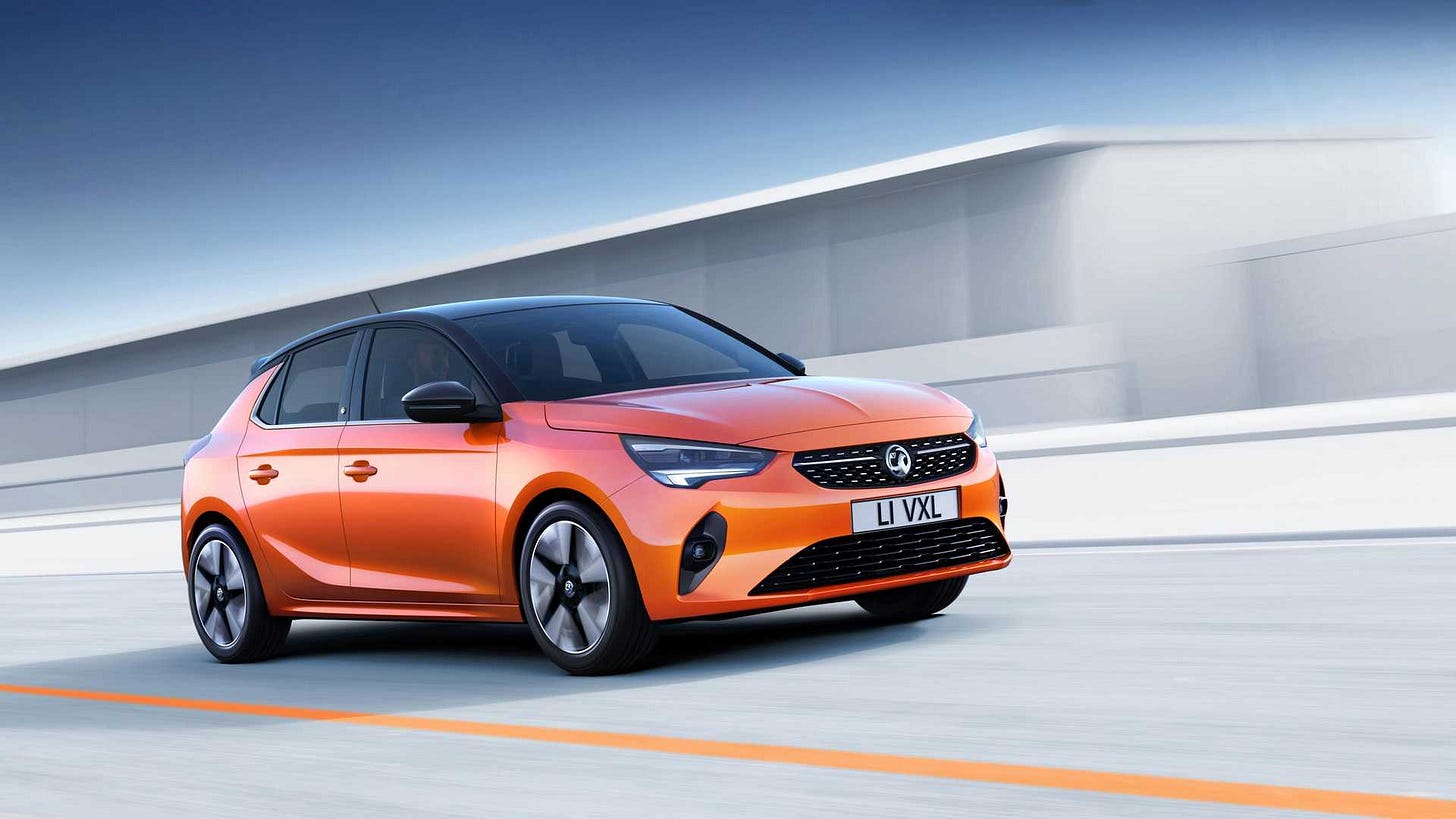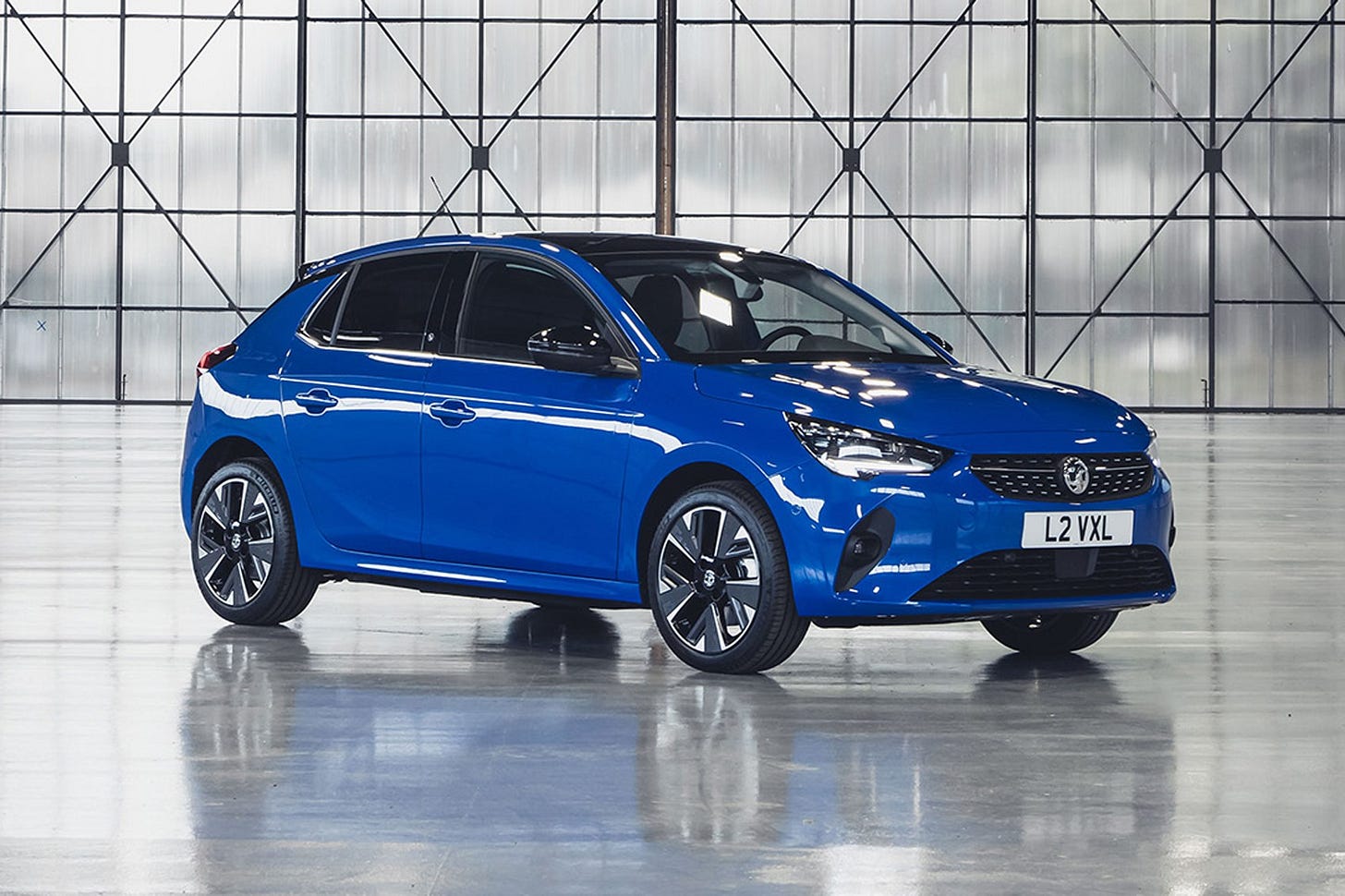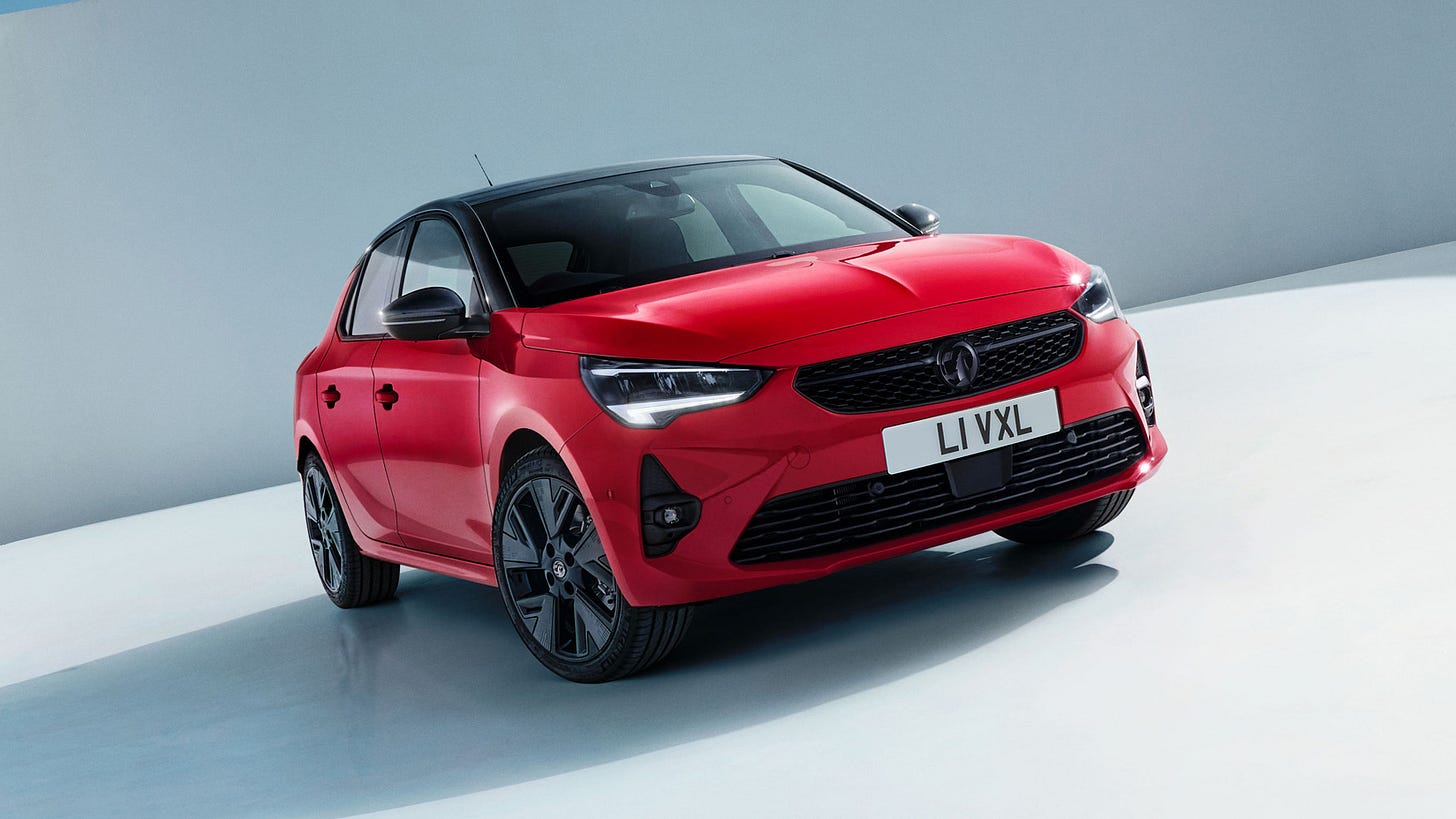Vauxhall Corsa-e
Hello, electric car lovers! In this blog, I cover all the latest tech news surrounding electric cars. I cover the background, feel and drive, the current selling price, and the specs and engineering that go into making each car. If you have an electric car that you’d like me to cover let me know in the comments below. In today's article, I’m reviewing the new Vauxhall Corsa-e. I’ll be covering the most important features to see whether it crushes the competition or not with its classic exterior, unlike most EVs. Oh, and one more thing before I start - I've never once been able to explain my car trouble to a mechanic without resorting to sound effects. Now, how am I going to do that with an EV?
Okkaayyyy... Now back to the article.
Background
Since 1982, the Opel Corsa has been a supermini vehicle designed and manufactured by the German automaker Opel. It was sold under a variety of different brands (most notably Vauxhall, Chevrolet, and Holden) and generated a number of different variations.
The Corsa was the best-selling vehicle in the world in 1998, with 910,839 sales and assembly operations on four continents. It was offered under five different GM brands and in five different body designs. Over 18 million Corsas will have been sold worldwide by 2020.
In December 2018, Opel announced the debut of the Corsa-e, an electric version of the Corsa that was supposed to go on sale in 2019, but was postponed until the second quarter of 2020. The Nissan Leaf and the Renault Zoe were supposed to be the Corsa-major e's competitors.
This new Vauxhall Corsa is undoubtedly the best-selling electric car in the United Kingdom. For a generation, the Vauxhall Corsa has been one of the best-selling vehicles in the UK, a favorite of driving instructors, first-time drivers, commuters, and fleet managers alike. Vauxhall's hatchback, on the other hand, has recently made the most innovative step yet. This is the Corsa-e, and it's an all-electric version of the popular supermini, as the name indicates.
The Corsa-e isn't lacking in showroom attractiveness, nor in the number of Vauxhall showrooms in which to be sold, since it is competitively priced and has a real-world electric range that beats a slew of other recently arriving zero-emissions rivals. The Corsa-e is one of an increasing number of compact electric vehicles available in the UK, but unlike many of them, it has the benefit of a well-known name. The Corsa-e is expected to be the first electric car for many more individuals, just as the Corsa supermini has been for many others over the years.
The story behind the new, sixth-generation Corsa is well known: it was hastily re-engineered from the ground up when Opel-Vauxhall was sold to the PSA Group, and it made it through development in record time as a sibling to the Peugeot 208. It is available with petrol, diesel, and electric drivetrains, with little difference between the variants aside from the obvious.
Vauxhall, like all PSA brands, is implementing this multiple powertrain choice, including electric, throughout future model lines rather than producing stand-alone electric vehicles because it feels that this makes electric a less scary move for purchasers.
Design and Engineering
If you're interested in purchasing a little electric vehicle but don't feel the need to brag about how innovative you are, the Vauxhall Corsa-e could be the vehicle for you.
When compared to alternatives such as the Honda e or Kia Soul EV, which have distinctive, quirky aesthetics to try to entice you into the all-electric revolution, the Corsa-e is more conservative in appearance but lacks the same cutting-edge flair. Consequently, if this automobile were nominated for an Academy Award for best supporting part, it would be nominated for best supporting role; it is a decent car, but the more gorgeous rivals would be competing for the main actor accolades.
The external appearance is similar to the standard Corsa, with a large grille in the front and stylish LED headlamp clusters in the back, as well as some strong creases down the sides and rear. There are a few 'e' emblems on the side and the back of the vehicle to indicate that it is an electric vehicle. It's still a shame that Vauxhall has taken some of the character and personality from its Peugeot brother, which is one of the best-looking and best-proportioned superminis on the market today.
Interior
According to Matt Watson from carwow, The interior of the Vauxhall Corsa-e is very similar to that of the normal Corsa. There are some piano black plastics and aluminum-colored trim pieces, but everything is conservatively fashioned, almost to the point of being dreary.
There are just two trim levels available: SE Nav and Elite Nav. The SE Nav has fabric seats, while the Elite Nav has half-fabric/half-faux-leather seats, but that's about it in terms of cosmetic distinctions.
The Corsa-interior e's is well put out for the most part, however the steering wheel obscures some of the heating and ventilation controls. This is especially problematic if you sit too far forward, since you won't be able to adjust the temperature without moving your head to the side.
Even if you place the seat as low as possible, the plastic shroud above the instruments may obscure the top of the two main dials if you're tall. As a result, checking your speed sometimes needs more than a quick glance.
A 7-inch touchscreen infotainment system is included on the SE Nav variant. It comes standard with DAB digital radio and Bluetooth, but it also includes Apple CarPlay and Android Auto smartphone mirroring.
A 10-inch version of the same system is included in top-spec Elite Nav automobiles. This time, it also has a built-in navigation system, though you'll be better off depending on the traffic information provided by your smartphone applications. The user experience on Apple and Android is also superior — Vauxhall's system has far too many little, difficult-to-hit on-screen buttons.
It's also worth noting that the Vauxhall's 10-inch screen appears to be smaller than it is. Everything is crammed into the middle of the screen, leaving large blank areas on either side. Visually, it isn't very appealing.
Performance
The front and rear tracks have been enlarged, the wheelbase has been somewhat increased, the front suspension has been toughened up, and the rear torsion beam has been shifted back slightly, all to fit the H-shaped 50kWh lithium ion battery pack in the floor.
The major attraction of the Corsa-e is its electric powertrain, as well as the charging technology it supports; the front axle is powered by a single 100 kilowatt electric motor. So much about the Corsa-e is defined by that battery. When you examine how its power is supplied, this is a clear assertion. According to test drivers, there is a normal push off the line when you initially accelerate, albeit it isn't as brisk or rowdy as other competitors. Performance drops down at roughly 50-60 mph, but in most situations, the real-world shove up to that point is all you'll ever need. When they trigger the kickdown, the ordinary Corsa buyer will believe they've accidentally wound up in a VXR with the mute button on.
However, the battery has a significant impact on the ride quality and handling. When compared to the normal Corsa, which is characterized as nobbly, the extra weight (345kg) actually aids the ride. The entire car appears to be more stable, with the Corsa-10% e's lower center of gravity also aiding. Although the ride is improved, some of the handling verve of the normal Corsa is lost on turn-in. However, it is stated that the steering has a great heft to it that wins you over in the end once you get accustomed to it, despite it initially seeming rather springy. The drive selection may change the amount of braking regeneration while driving, and the Corsa-brake e's pedal feels natural and compares favorably to petrol equivalents.
On a rocker-style switch next to the drive selection on the center console, you may choose between three driving modes. When you start the Corsa-e, it will default to Normal, and you should be able to get roughly 180 miles of real-world range on a full charge. The power output in Normal mode is limited to 108bhp. It's a well-balanced baseline setting that nails the trade-off between efficiency and power, so you won't feel compelled to switch to Sport mode. If you do that, your range will drop, but you'll receive 100 kw to the front wheels. That makes it snappy, turning the greenest Corsa into the fastest model off the line by a long shot, accelerating from 0 to 60 mph in 7.6 seconds and with rapid throttle response. It also adds a level of enjoyment that the chassis alone lacks. Sport mode will make your travel faster and more enjoyable if you have shorter journeys in mind and charging is accessible at the other end. The available power is reduced to 60 KW, and the throttle response is numb. It will increase your maximum range, but it will take a long time to get used to.
Battery Life
In terms of its EV vitals, a real-world range of 200 miles on mixed road conditions is to be believed in the summer when driven in the 'B' mode, which activates a well-judged regenerative braking system. The Corsa-e comes included with a home charger and allows 100kW DC quick charging. Keep the Corsa-e in Normal mode and rely on its amazing standard charging technology.
At a proper CCS-equipped charging station, the Vauxhall can charge at a rate of up to 100kW, allowing you to charge from empty to 80% in roughly 30 minutes. Away from quick chargers, the Corsa-charge e's rate is capped at 7.4kW, and Vauxhall will include a complimentary Pod Point home wallbox that permits overnight recharges in about seven and a half hours. It's possible to get faster 11kW three-phase charging, but it's probably not necessary. If you top up the car at home, expect to pay roughly £8.25, however this fluctuates depending on how much power you pay. However, for the same distance, it is still less expensive than a Corsa with a petrol or diesel engine.
Price and Modal Range
The Corsa-e makes a good argument for itself as an introduction to the world of electric automobiles. The driving experience isn't as revolutionary as some, and the interior and exterior appearance is even less so, but the feeling of familiarity is where this car truly shines. Here are the prices of each trim:
The SE Premium trim costs around $33,573
The SRi Premium trim costs around $35.000
The Elite Premium trim costs around $37.000
It's the EV for individuals who didn't realize they wanted one and buy one without thinking about it - exactly the type of vehicle the government needs to sell in droves if its goal of reducing the use of internal combustion engines is to be realized.
On the other hand, it's tough to deny that the Corsa-e is expensive to finance. The Peugeot e-208 seems more premium and gives the same basic charging choices and range for less money per month, and you could be tempted to choose the e-208 Allure Premium, which has a comparable amount of gear to the Vauxhall but has a higher interior quality. You'll have to pay a lot more upfront for the Vauxhall than you would for the Peugeot to receive a comparable monthly rate.
This wraps up my review of the Vauxhall Corsa-e, let me know what you think of it. Thank you for sticking it out through to the very end of this article! Nothing helps out my blog more than you all reading the entire article. These articles take a long time to make and are a labor of love. If you would like to see my blog grow, please help spread the word and until next time, remember, the best experiences aren’t about where you end up, but who you’re lucky enough to be on the journey with.






